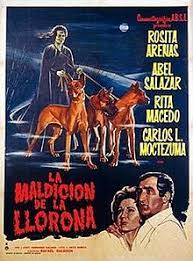
A carriage carrying three passengers, two men and one woman, is stopped in a dark forest. A woman with empty eye slits is holding the leashes of several emaciated Great Danes. Her servant kills the driver and one of the male passengers. The other male runs away but is overtaken and attacked by the dogs. The woman passenger faints and is run over by the carriage.
Emily/Amelia (Rosita Arenas) has been summoned to visit her Aunt Selma (Rita Macedo). Selma lives in a rundown Hacienda in the countryside. She lives there with only a servant, a crook-necked degenerate named Juan (Carlos Lopez Moctezuma). Emily brings along her new husband Herbert/Jaime (Abel Salazar). Selma is not pleased that Emily married but there is nothing she can do about it.
Tomorrow Emily will turn twenty-three. Selma takes her aside and explains to her the family legacy and her part in it. Selma explains that after Emily’s parents died Selma sent her to a boarding school so that her uncle, Selma’s husband Daniel (Enrique Lucero), could work on his research on therapeutics. Selma began studying black magic and a woman called La Llorona (the weeping woman). According to Selma, La Llorona was a witch with immense power. Power that Selma also wanted. Selma gave herself to the dark powers and is now a witch herself. She has no reflection and has a thirst for blood.
Selma then takes Emily into an underground cavern where the ancient witch is shackled and a lance is shoved deep into her heart. Centuries ago she had been sentenced to death. Since the witch is technically immortal she is alive but pinned and unable to wield her power. Selma tells her that they are actually descendants of the witch and are the last of her legacy. It is Emily’s destiny to revive the witch by removing the lance. When that happens she will return with all her powers and so will Selma and Emily. Selma tells her that at the proper time the old bell in the tower of the hacienda will begin to strike. When that happens Emily must remove the lance from the witch’s heart to restore her power.
“The Curse of the Crying Woman” AKA “La maldición de la llorona” was made in 1961 but released in 1963 and was directed by Rafael Baledon. It is a Mexican horror movie. The film has gone through a beautiful restoration; however, I don’t have a copy of it. All I have is a very bad print. Despite that the movie is still great. This is one of K. Gordon Murray’s films that he bought and dubbed into English so, in the American version, some of the characters names have been Americanized.
It is a wonderful film and really fun film and a good example of Mexican horror. Along with the cheap special effects are some really cool ones. Portions of Selma’s tirade when she is mesmerizing Herbert uses stock footage from other Abel Salazar Mexican horror movies such as “The Man and the Monster” 1959, “Brainiac” 1961, “El Mundo de los Vampiros” 1961 but in negative. It adds a nice touch to the film.
Although the film title is a reference to the Mexican legend of the Crying Woman, the movie has nothing to do with the legend and in fact is more like Mario Bava’s “Black Sunday” 1960. There is a nice little nod to “Black Sunday” where, in the beginning of the film Selma is holding the leashes of the Great Danes. There is also a nod to “Dracula” 1931 where Selma walks through a spider’s web without disturbing it.
There are some variations to the story but according to the legend La Llorona was a woman named Maria who married a rich man and had two children. Eventually her husband began to ignore her but was devoted to the children. When Maria caught her husband cheating on her she killed her children to get back at him. She immediately regretted what she did and cried out for them. When Maria died she was denied entry into heaven and was banished to purgatory on Earth until she could find her lost children. From then on she has been known as “La Llorona” or “The Weeping Woman” and roams the night. She has also been called “The Crying Woman” or “The Wailing Woman”. Some versions say she kidnaps children or cheating husbands. The legend has inspired other movies such as the Mexican film “La Llorona” 1933, “KM 31: Kilómetro 31” 2006, and “Mama” 2013.

